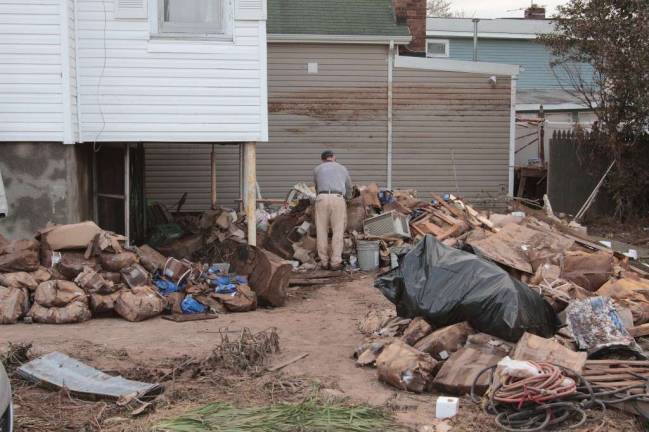8 Million Stories: Forgotten Island, New York

by Ben Crompton "Looks like food's not the problem in Staten Island," I say. Photographer Ross Terelle and I walk through dark streets lined with great mounds of garbage that used to be people's lives. It's a week after Hurricane Sandy hit. Most of the people we've met along the way have been trying to give food to us and to each other: "You guys need some hot coffee?" "We got pasta, you guys hungry? You seen anybody who needs some hot food?" "Pizza anybody? It's still kinda warm." We pass a man standing in the doorway of a house that God must have punched, on Hunter Avenue. I ask him what happened and his story spills out in Spanish-inflected English-a messy narrative interrupted from time to time by people begging to give us food. His name is Alfredo Zapata. During Irene last year, the water level only rose a couple of feet, so he decided to stick it out. He put boots on and sloshed through knee-high water with his neighbor, surveying, protecting his house from the thieves who work disaster areas. This year they did the same but the results were different. Zapataand his neighbor barely made it to his house. They shut the door and then watched in terror as the water surged through his neighborhood. Wave after wave-he called them tsunamis-brought the water to within six inches of his ceiling, where it stagnated for a day, leaving a brown ring of grime to mark an astonishing high water mark. "That's got to be twelve feet," says Terelle. "At least," I say. Zapatainvites us in. His house is empty; he lost everything. The floor is a layer of brown filth and foam, the walls are grimy, the framing shows through where the drywall has crumbled away, and the walls that remains are soft to the touch. The smell of mold and rot is overpowering. A young couple comes to the door and poke their heads in. "We have hot coffee and hot chocolate. Anybody?" Zapatagraciously declines and sends them on their way. When they are gone, he points to a green sticker on the door. An inspector came and told him his house was habitable. "He looked in and said, 'Uh, well, you can live here.'" He imitates the inspector's voice with a generous dose of idiot. "'Well, maybe dry it and you can sleep here. I'm going to put a green sticker on your door saying you can live here.' Come on! You think a child could live here?" Terelle and I shake our heads. He snaps pictures. I don't think a prisoner should live in this place. "This is the same story for all my neighbors," says Zapata. "They're complaining. They say the government forgot us. They're helping Long Island, Brooklyn, Manhattan. This is not Staten Island, this is Forgotten Island." In the distance a sound like the Muslim call to prayer, but muffled, echos through the neighborhood. It's a truck with a bullhorn: "We...have...food. We...have...water." "We...have...food. We...have...water." It could be something official-NYPD, Red Cross, FEMA-or it could be a local church or a youth group or volunteer firefighters or bunch of friends who feel guilty for being warm. The Occupy movement has been ferrying food and supplies to the hardest hit areas. But nobody has come by handing out lawyers or a warm place for Zapata'sfamily to live. I imagine he would line up for that truck. He tells us some of the Staten Island deaths occurred within a stone's throw of his house. The neighbor who died trying to save her dog. Two children drowned down the road. A couple in the house on the corner. And there could be more. He worries about the illegals hiding from the authorities; people waiting in the dark, afraid to light candles or turn on generators for fear of being expelled from Forgotten Island. We thank Zapataand wish him luck-both come out hollow-and leave him standing in his doorway thanking-but-no-thanking people, waiting for his insurance company to call him back. Back on the street, we walk gingerly around piles of busted dreams towards the safety of the Midland Beach Distribution Center.